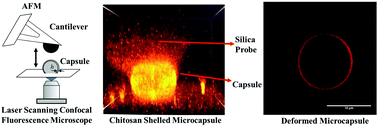Ultrasonically synthesized organic liquid-filled chitosan microcapsules: part 2: characterization using AFM (atomic force microscopy) and combined AFM–confocal laser scanning fluorescence microscopy†
Abstract
Atomic Force Microscopy (AFM) is used to measure the stiffness and Young's modulus of individual microcapsules that have a chitosan cross-linked shell encapsulating tetradecane. The oil filled microcapsules were prepared using a one pot synthesis via ultrasonic emulsification of tetradecane and crosslinking of the chitosan shell in aqueous solutions of acetic acid. The concentration of acetic acid in aqueous solutions of chitosan was varied from 0.2% to 25% v/v. The effect of acetic acid concentration and size of the individual microcapsules on the strength was probed. The deformations and forces required to rupture the microcapsules were also measured. Three dimensional deformations of microcapsules under large applied loads were obtained by the combination of Laser Scanning Confocal Microscopy (LSCM) with Atomic Force Microscopy (AFM). The stiffness, and hence the modulus, of the microcapsules was found to decrease with an increase in size with the average stiffness ranging from 82 to 111 mN m−1 and average Young's modulus ranging from 0.4 to 6.5 MPa. The forces required to rupture the microcapsules varied from 150 to 250 nN with deformations of the microcapsules up to 62 to 110% relative to their radius, respectively. Three dimensional images obtained using laser scanning confocal microscopy showed that the microcapsules retained their structure and shape after being subjected to large deformations and subsequent removal of the loads. Based on the above observations, the oil filled chitosan crosslinked microcapsules are an ideal choice for use in the food and pharmaceutical industries as they would be able to withstand the process conditions encountered.



 Please wait while we load your content...
Please wait while we load your content...